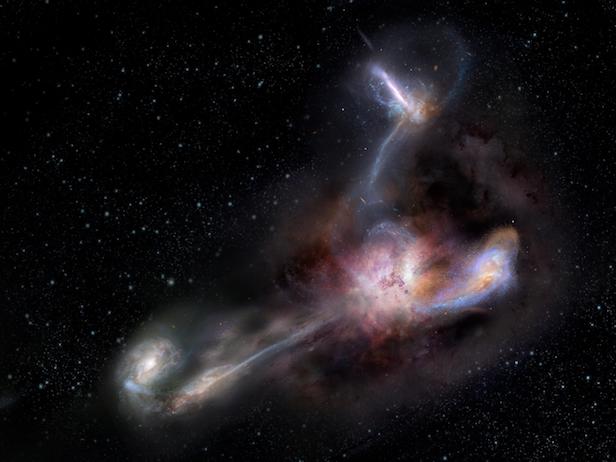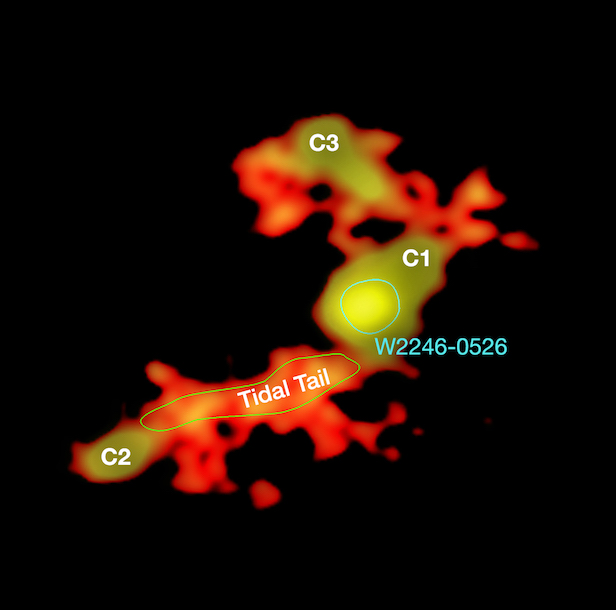What’s the secret to the most luminous galaxy’s incredible brightness?
The secret ingredient is stealing the material from at least three neighbouring galaxies

A new study using data from the ALMA shows that W2246-0526 is syphoning dust and other material from three of its smaller galactic neighbours. Image credit: (NRAO/AUI/NSF) S. Dagnello
The most luminous galaxy ever discovered is cannibalising not one, not two, but at least three of its smaller neighbours, according to a new study published on 15 November 2018 in the journal Science and co-authored by scientists from NASA’s Jet Propulsion Laboratory in Pasadena, California, United States. The material that the galaxy is stealing from its neighbours is likely contributing to its uber-brightness, the study shows.
Discovered by NASA’s space-based Wide-field Infrared Survey Explorer (WISE) in 2015, the galaxy, called WISE J224607.55-052634.9, is by no means the largest or most massive galaxy we know of, but it radiates at 350 trillion times the luminosity of the Sun. If all galaxies were positioned an equal distance from us, WISE J224607.55-052634.9 (or W2246-0526 for short) would be the brightest.
New observations using the Atacama Large Millimeter/submillimeter Array (ALMA) in Chile reveal distinct trails of dust being pulled from three smaller galaxies into W2246-0526. The trails contain about as much material as the smaller galaxies themselves, and it’s unclear whether those galaxies will escape their current fate or will be completely consumed by their luminous neighbour.
Most of W2246-0526’s record-breaking luminosity comes not only from stars, but also a collection of hot gas and dust concentrated around the centre of the galaxy. At the heart of this cloud is a supermassive black hole, recently determined to be four billion times more massive than the Sun. In the intense gravity, matter falls toward the black hole at high speeds, crashing together and heating up to millions of degrees, causing the material to shine with incredible brilliance. Galaxies that contain these types of luminous, black-hole-fuelled structures are known as quasars.
Like any engine on Earth, W2246-0526’s enormous energy output requires an equally high fuel input. In this case, that means gas and dust to form stars and to replenish the cloud around the central black hole. The new study shows that the amount of material being accreted by WJ2246-0526 from its neighbours is enough to replenish what is being consumed, thereby sustaining the galaxy’s tremendous luminosity.
“It is possible that this feeding frenzy has already been ongoing for some time, and we expect the galactic feast to continue for at least a few hundred million years,” says Tanio Diaz-Santos of the Universidad Diego Portales in Santiago, Chile.
In the new study, the scientists used images from ALMA – a collection of individual radio antennas that work together as single telescope – to identify the dusty trails of material. The position of the accretion trails strongly suggests they contain material flowing between W2246-0526 and the other galaxies. In addition, the trails exhibit the right morphology – that is, the shape of the trails is consistent with how the material should flow if it is being pulled from one galaxy into another.

Radio data from the ALMA shows how W2246-0526 is being fed by three companion galaxies (C1, C2, and C3). A large tidal tail connects C2 with the main galaxy; dust bridges connect the other two galaxies to W2246-0526. Image credit: T. Diaz-Santos et al./N. Lira/ALMA (ESO/NAOJ/NRAO)
This kind of galactic cannibalism is not uncommon. Astronomers have previously observed galaxies merging with or accreting matter from their neighbours in the nearby universe. For example, the pair of galaxies collectively known as “the Mice” are so named because each has a long, thin tail of accreting material stretching away from it.
W2246-0526 is the most distant galaxy ever found to be accreting material from multiple sources. The light from W2246-0526 took 12.4 billion years to reach us, so astronomers are seeing the object as it was when our universe was only a tenth of its present age of 13.8 billion years. At that distance, the streams of material falling into W2246-0526 are particularly faint and difficult to detect. The study relies on 2.5 hours of observation time using 40 of ALMA’s 12-metre (39-foot) radio dishes.
“We knew from previous data that there were three companion galaxies, but there was no evidence of interactions between these neighbours and the central source,” says Diaz-Santos. “We weren’t looking for cannibalistic behaviour and weren’t expecting it, but this deep dive with the ALMA observatory makes it very clear.”
W2246-0526 falls into a special category of particularly luminous quasars known as hot, dust-obscured galaxies, or Hot DOGs. Astronomers think that most quasars get some of their fuel from external sources. One possibility is that these objects receive a slow trickle of material from the space between galaxies. Another is that they feed in bursts by eating up other galaxies, which appears to be occurring with W2246-0526. It’s unclear whether W2246-0526 is representative of other obscured quasars (those with their central engines obscured by thick clouds of dust) or if it is a special case.
“This galaxy may be one of a kind, because it’s nearly twice as luminous as any other galaxy we’ve found with WISE and it formed very early in the universe’s history,” says Peter Eisenhardt, JPL project scientist for WISE. “But we’ve discovered many other galaxies with WISE that are similar to this one: distant, dusty and thousands of times more luminous than typical galaxies are today. So with W2246-0526, we may be seeing what goes on during a key stage in the evolution of galaxies and obscured quasars.”
Ultimately, the galaxy’s gluttony may only lead to self-destruction. Scientists hypothesise that obscured quasars that gather too much material around them end up vomiting gas and dust back out through the galaxy. This onslaught of material halts the formation of new stars, essentially pushing the galaxy into retirement while other galaxies continue to renew themselves with the birth of new stars.
A companion study about W2246-0526, published on 14 November 2018 in the Astrophysical Journal, provided the mass measurement for the supermassive black hole at the galaxy’s centre – four billion times the mass of the Sun. This mass is large, but the extreme luminosity of W2246-0526 was thought to require a supermassive black hole with a mass at least three times larger, according to the paper authors. Solving this apparent contradiction will require more observations.
Keep up to date with the latest news in All About Space – available every month for just £4.99. Alternatively you can subscribe here for a fraction of the price!




